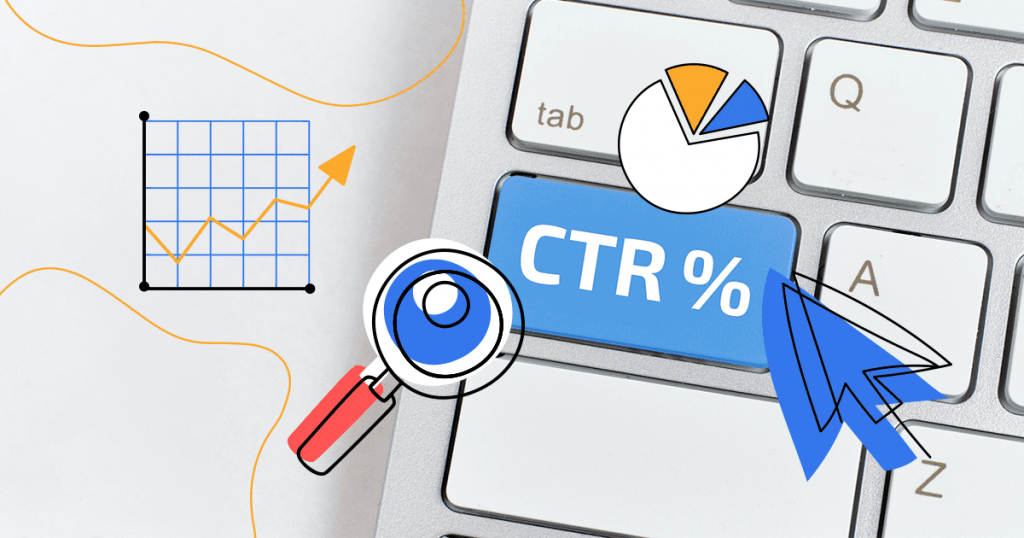It doesn’t matter if you are applying SEO techniques or investing in sponsored links; certain metrics are fundamental to improving your Digital Marketing strategy’s performance and success.
Take, for example, your CTR (Click-Through Rate), a very important indicator of any strategy.
The higher an advertisement’s CTR, the more your business benefits, through lower costs to a better ranking in organic searches.
But how to efficiently grow this metric? Continue reading this article to understand:
- What is CTR?
- How to calculate CTR?
- What is CTR for?
- What is the relationship between CTR, CPC and CPM?
- Why track this metric?
- How do I know if CTR is high or low?
- How to increase the CTR of keywords and ads?
Download this post by entering your email below
What is CTR?
CTR is a key indicator of Digital Marketing, revealing the relationship between the number of views and the number of clicks of an ad.
In practice, this metric indicates how effective a campaign is: the percentage of users who click on your link after viewing it.
As a result, CTR is an important metric for evaluating ad performance, whether through Google Ads or ads on social networks.
The click-through rate ultimately impacts your campaign’s cost and your page ranking in organic searches.
How to calculate CTR?
Although CTR is an extremely important metric, it’s simple and quick to calculate. Just divide the number of times an ad was clicked by the total number of views it received (also known as impressions). Thus:
Number of clicks ÷ number of views = CTR.
For example:
If your keyword has 60 clicks and 6,000 impressions, your CTR will be 1%.
What is CTR for?
Among growing competition for consumer attention and resources, it’s essential to know your marketing plan’s real efficiency. This covers all of the strategies and actions adopted to impact your user. CTR serves exactly this purpose: to evaluate the quality of your keywords and, consequently, your ads.
So if you’re looking to better invest available resources and manage performance through more precise actions, even with little investment, click-through rate is a key resource.
By applying it, you can identify which campaigns are most efficient, by determining which catch the user’s attention the most and lead to them clicking on a link.
This metric allows you to understand your strategies’ true efficiency, essentially the best way to assess whether your strategy is being applied correctly.
By doing so, it becomes much simpler to take action that generates a greater impact on the user. You can identify which campaigns work best and which need to be improved.
What is the relationship between CTR, CPC and CPM?
Before diving into how to monitor this metric closely, it’s also necessary to understand the relationship between CTR and the other important acronyms for the success of your Digital Marketing strategies.
The Click-through rate ends up directly related to CPC and CPM.
CPC (Cost Per Click) is one of the most common ad pricing schemes on the market. In this format, you only pay for clicks your campaign receives; in other words, views (impressions) are not included.
In practice, you will only be charged for users who access your pages by clicking on ads.
CPM (Cost per Thousand Impressions), on the other hand, is a format that prices the cost of a campaign by the number of views (impressions).
For every thousand users impacted by your ad — without the need for a click — you will pay a stipulated amount, regardless of the campaign’s efficiency.
But what is the relationship between these two acronyms and CTR? The click-through rate directly influences both pricing models. CPM isn’t as strongly affected, as it doesn’t matter how many people actually click on your ad.
However, CTR is essential for those who choose a CPC model for pricing. After all, the higher the click-through rate, the greater the efficiency of your ads.
Ultimately, this indicates that they are useful for users. As a result, CPC becomes cheaper, and search engines better understand what your link has to offer.
Why track this metric?
There are diverse reasons to follow CTR, which get divided not to waste your time and allow you to invest in the best ways to increase this metric as soon as possible, guaranteeing the best results for your business.
Quality Improvement
CTR is one of the factors that make up the Google Ads Quality Score, a calculation the platform makes to determine the ranking of each ad.
To do so, other topics are taken into account, such as the user experience on the landing page and the relevance of the content.
However, the most important component of quality is, without a doubt, the CTR of a campaign.

Google realizes that a high click-through rate is a strong indicator that an ad’s content is actually relevant to users. Therefore, higher CTR impacts the quality and where your ad ranks.
Cost reduction
A high CTR means your ad needs to appear fewer times to receive a high number of clicks. The good news is this is exactly what Google values.
After all, your campaign is proving relevant, appearing to its exact target audience, so users can find precisely what they’re really looking for.
In the end, your ad gains a more relevant ranking, and the campaign’s average CPC is reduced.
Better organic ranking
To achieve a higher position in an organic search, the main tactic is to apply SEO (Search Engine Optimization) techniques, right?
A higher CTR also represents a better ranking, since clicks generate traffic for your pages, which indicates to Google that that destination is actually relevant to the user.
Increased (free) visibility on social networks
When it comes to social media ads, a higher CTR represents high user engagement.
In addition to reducing campaign costs, these platforms offer another benefit: free advertising. The more people sharing and clicking on your posts, the more free clicks.
If someone shares a publication driven by your business on Facebook, other people will be impacted, and, best of all, you’re not charged for any resulting interaction. The same goes for Twitter.
Conversion rate hike
Another benefit of keeping a close eye on CTR and making sure it’s satisfactory is the conversion rate of your ads.
For example, the chart below shows a direct relationship between the two indicators. Thus, a two-fold increase in your click-through rate can result in a 50% higher conversion rate.

How do I know if CTR is high or low?
In practice, the higher your CTR, the better for your business. Generally, a click rate of 3% or more is considered satisfactory.
To assess whether this metric is high or low, you must consider your business segment and the performance of competitors, in addition to your experience with ads.
The main comparison should be with the CTR of your competitors for a particular keyword.
After all, a lower click-through rate than a competitor means that Google sees your page as less relevant than other companies.
Therefore, a CTR of 3% — which can be considered good in certain situations — is useless if, in practice, your direct competitor has a click-through rate of around 5%.
Thus, determining a satisfactory value depends directly on your campaign’s performance in relation to competitors’ ads.
In addition, when examining this metric closely, don’t forget to separate campaign models, since the performance of an ad through search may differ whether the goal is more views or more clicks.
How to increase the CTR of keywords and ads?
To increase your CTR as quickly as possible and improve the efficiency of your marketing actions, we’ve separated some important steps to optimize the click-through rate of your keywords and ads.
Insert the main keyword in your ad
Choose your ad group’s primary keyword and insert it naturally in your text and headline.
You can also use the {keyword: default word} code to have your advertising updated automatically with your group’s keywords.
When you do this, the user’s experience will be even more positive, as they will see the exact term they searched for.
Remove irrelevant terms
It’s very difficult to have an optimized campaign without removing terms that are irrelevant to your business.
It makes no sense to spend money on advertising that will never get used.
So, prepare a list of negative words based on search terms that don’t apply to your service/product.
Go all out on CTA
Engaging call-to-action (CTA) ads are indispensable for improving your CTR. Make it very clear what you expect your user to do.
Invest in expressions like “sign up now” or “call us” and provide a landing page that allows users to complete this action.
Take advantage of ad extensions
Did you know that there is a range of extensions on Google Ads that can be used according to your campaign’s purpose? These allow you extra space to include your contact details, website link, or physical address.
One tip is to never include the contact directly in the text. Instead, invest in mental triggers to make your content more attractive.
Adjust the URL
Internet users usually pay close attention to the URL to see if the address they’re being sent to has the search term they’re looking for.
Anything unfamiliar, they quickly retreat! So, choose site + keyword and run tests to measure how your audience accepts specific terms.
Invest in seasonal dates
Take advantage of seasonal dates that generate business — Mother’s Day, Black Friday, and Christmas.
This is an excellent way to focus your business segment and increase your CTR. Schedule your ads to rank well during those times.
Also, avoid making changes to your campaign settings on a daily basis. Give them about 3 days to gain in-depth observations.
Develop an efficient strategy
An efficient strategy leads to naturally better results. This makes it easier to achieve higher ad placement.
The truth is, more than spending, good planning increases your company’s return on investment (ROI). To do so, put all your ideas down on paper and see if it’s worth hiring a digital agency with trained professionals to increase your conversion rate.
In Digital Marketing, it becomes clear how closely monitoring different metrics is beneficial to your planning’s success.
In addition to indicating when a campaign is working as expected, an increased CTR benefits other aspects of your strategy, further optimizing the performance of your actions.
As you could see, the CTR impacts directly in Google’s ranking. Thus, to have better results, it is important to apply everything you learned here to other SEO techniques. To know them better, download our complete SEO guide!








